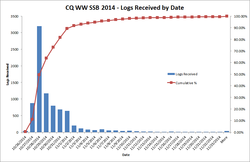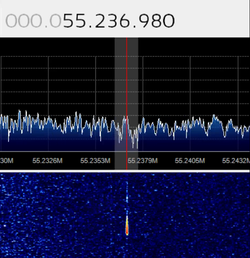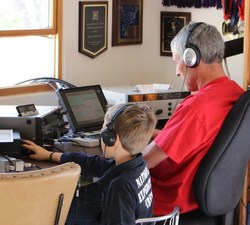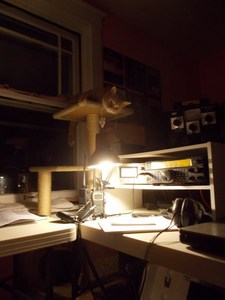 December 31, 2014 Editor: Ward Silver, NØAX | |||||||
IN THIS ISSUE
NEW HF OPERATORS - THINGS TO DO How about a few New Year's Day contests? Turn on the radio and catch some action in the QRP ARCI New Year's Sprint, the New Years Snowball Contest, the SARTG New Year RTTY Contest, or the AGCW Happy New Year Contest. You can find the links to the rules in the contest listings below. BULLETINS The ending time for the ARRL January VHF Contest is 0359 UTC on January 26th. It was mistakenly listed as 2359 UTC in January's "Contest Corral". A corrected PDF version of the column is available online. (Thanks, Mike K2MK) BUSTED QSOS The call sign 4J1VR should have been 4V1JR. (Thanks, Charlie N1RR) CONTEST SUMMARY Complete information for all contests follows the Conversation section January 3-4
January 10-11
After a run of nearly 40 years, the North American Phone Sprint has been discontinued. As new editor Pat N9RV explains in the Jan/Feb 2015 issue of the National Contest Journal, as a result of declining participation, "the operating experience that continues to make the CW Sprint so special is essentially lost." NCJ remains open to trying new and innovative contest formats, particularly for SSB operators. Past Phone Sprint participants are considering running their own version of the contest, as well, so stay tuned for future announcements.
Rules for the ARRL January VHF Contest have been updated for Single-Op Unlimited and Unlimited Rover categories. Check out the rules before the contest! Thanks to Chip Sufitchi N2YO the European Space Agency's new satellite tracking widgets are live. The widgets are fed with the latest orbital tracks for ESA missions, or missions with significant ESA participation. The default track shows the ISS but there are 17 other tracks to explore! (From AMSAT News ANS-355) Registration is now open for the Ninth 2015 Dayton ConTest University ("CTU") to be held all day on Thursday May 14, 2015 at the Crowne Plaza in Dayton, Ohio. Eight different countries have hosted CTUs over the years; USA, Australia, Russia, Germany, Italy, England, Brazil and Finland. Over 3700 students have attended CTUs with more than 80 CTU Professors sharing their contesting experiences. CTU Caribbean will be held next month at the ARRL Puerto Rico Convention! (Thanks, CTU Chairman, Tim K3LR)
When do contest logs really come in? Are they spread out throughout the submission period? How many sneak in at the deadline and how many are late? CQ World Wide DX Contest Director, Randy K5ZD put together this chart showing how the logs are submitted over time. Don't miss that deadline! Web Site of the Week - The ARRL has published a revision to the HF Contesting Guidelines. The revisions by a team of CAC members (K5KG, N3BB, K3WW, W1UE) address changes in technology that have affected HF contesting in recent years and present a current understanding of HF contesting standards and practices. (VHF+ contesting is not addressed.) Additionally, sections of the previous document were rewritten and reorganized to improve readability. The goal of the guidelines is to provide guidance and advice, especially for new contesters, and to encourage contest operation that advances the spirit and integrity of radiosport. (Thanks, George K5KG) WORD TO THE WISE Enjoy being with your families, thank your lucky stars for what and who you have, wish for those who are hurting to be less so, and remember those who blazed a trail for us. If you've ever wondered what the operators experience at some of those remote UA9 and UAØ stations, this New Yorker article about a Siberian weatherman gives an idea, along with some great photographs. (Thanks, Trey N5KO)
What does a ping sound like? You can hear real time audio related to meteor activity on the LIVEMETEORS website run by the same Chip N2YO who developed the ESA widgets mentioned previously. He uses an SDR receiver in the Washington, DC area tuned to 55.23693 MHz with a Yagi pointed toward a Channel 2 television station in Canada. The page also features both a spectral and a waterfall display as seen in the photo at right. (From the ARRL Propagation Bulletin ARLP052) We're not supposed to look right at the Sun, but NASA's NuSTAR satellite does that all time - and in X-rays - taking high-resolution photos that will give us a better idea of what the Sun is doing. When stuff gets so hot it turns magenta, you know the burner is set on HIGH! (Thanks, Kirk K4RO) I think I saw a few folks wearing this handsome heap of ham haberdashery at recent hamfests. (Thanks, Eric W3DQ) Imagine you, played by a watermelon, taking on a fully charged high-voltage capacitor. Don't try this at home...and switch to safety! On a larger scale, Connecticut Light and Power has been demonstrating some exciting new splicing technology on their high voltage distribution lines - also quite impressive. Congratulations to another crop of Rookies who tried out their CW skills in the Dec 21st edition of the ARRL Rookie Roundup. Results have been released and Bill AEØEE was the top score - with a call like that, he must be a CW operator! Bill encourages other new hams to try CW; "I'd strongly urge you to get involved with the Straight Key Century Club, whose members provided a great number of QSOs during the Rookie Roundup. Their monthly sprints and weekend sprintathon are lots of fun, and with an exchange that is generally easier to understand. When your CW gets faster, the Sweepstakes and the other non-rookie contests can be very exciting."
ARRL Contest Branch Manager, Matt W1MSW reports that 2014 RTTY Roundup certificates went out on December 22nd and 2014 ARRL DX Plaques went out on December 30th. Watch those mailboxes! Results for the 2014 Canada Day contest are posted on the Radio Amateurs of Canada (RAC) website. Certificates will be sent out via email, so look for them starting in late January. (Thanks, Bart VE5CPU) The preliminary results of the 2014 Worked All Germany Contest are online along with a first contest and log check report. Your personal logcheck report is available via the link/password received with the email robot's confirmation after submitting a log. If you lost the access information please send a mail to the WAG information address. (Thanks, WAG Contest Manager, Chris DL8MBS) The official results of the 2014 Ten-Meter RTTY Contest have been posted on rttycontesting.com. All results, past and present, including a scores database, can be found via the Ten-Meter RTTY Contest menu. As an added bonus, there is an article by Mark K6UFO about the remote operation he and Tom ND2T used at W1LQ and KH6TU. (Thanks, Don AA5AU and Ed WØYK) Results of the 2014 Ukrainian DX Contest are now available from the contest website. (Thanks, URDXC Contest Committee, Vladimir UT1IA) Final results of the 2014 YO DX HF Contest are now online. (Thanks, Andy YO3JR) OPERATING TIP After each big contest (and some little ones) there is a big online discussion about duplicate contacts. Do you log them? Do you tell the caller they are a dupe? Are there penalties for submitting a log with duplicate QSOs? The general consensus is that you should just log the new contact - it might save you or the other station from getting a NIL (Not In Log) penalty if the earlier contact wasn't successful on either end. As CQ WW Director, Randy K5ZD says, "Working dupes is good. There is no downside from logging a station a second time." CQ WW RTTY Manager, Ed WØYK observes, "Contesting is a cooperative sport where competitors must work together to create a valid QSO in both logs that each gets credit for. To that extent "I am my brother's keeper". Working dupes supports this paradigm." One lesson here is that you need to learn how to force logging a dupe in your software - such as ALT-Enter in N1MM. Software authors, please support logging duplicate QSOs! The sophistication of RF instrumentation available to the amateur continues to increase at an amazing pace, such as this "Poor Ham's Scalar Network Analyzer" based on an Arduino processor and a pair of Analog Devices ICs. (the AD9850 DDS module and AD8307 RF power detector) Work is progressing on a hand-held version. (Thanks, Jim N5IB)
When getting ready to pour concrete for a tower base, it's important that the rebar not sit directly on the dirt where it will get wet and rust away. Skip KJ6Y relayed the recommended solution, dobie blocks. He also cautions against using regular bricks that will absorb moisture that causes the rebar to rust. Dobie blocks are available where you buy the rebar or concrete. In addition to Amateur Radio, Les N1LF has recently gotten involved in model railroading. "While looking for specialty tools for these tiny machines, I came across a company called Micro-Mark of Berkeley Heights, NJ. Their website and wonderful catalog contain not only tools of great use to modelers, but anyone who works with small components. There is a wealth of products ranging from hand tools, jigs of all kinds, magnifiers, 3-D printers, small lathes, and so much more." Steve WA7DUH has put together this PowerPoint slide deck covering the basics of baluns. Once familiar with the technology, this paper from DX Engineering will help you choose the right type of balun for your particular needs. (Thanks, Don KD8NNU) Visualizing the pattern of antennas is often challenging and that's where some software can be a huge help. Bob KA5MCO suggests taking a look at the website of Paul Falstad. If your web browser can run Java applets, Paul's various electromagnetic simulations can help you imagine what's going on with various antennas. (The antenna applet is in the Electrodynamics section.) Not only that, you can change the parameters of the antenna and see the effects in real time! There are quite a number of other useful simulations, as well. Technical Web Site of the Week - Here in the middle of low-band season and with CQ WW 160 coming up, "Beverage On Ground (BOG)" antennas have been discussed lately. Bruce K1FZ has put together a web page discussing this variation of the Beverage design, answering some questions about how well it works, terminating the antenna, and other common questions. A Simple Delight As you know, the ARRL's Centennial QSO Party ends TODAY - can 3.5 million QSOs be wrong? That's one heckuva lot of QSOs (and QSLs) for what has been the biggest on the air ham radio event of all time! While I've certainly enjoyed being on both sides of those pileups, the best part of this adventure for me has not been my own experiences. Rather, it has been hearing entirely new calls and their stories of getting on the air to work W1AW/portable or W100AW. At 0000 UTC on January 1st, all of us, old and new operators alike, will be asking, "Now what?" We've enjoyed quite a year of looking back at the long history of Amateur Radio and the ARRL's part in that history. As we sing our auld lang synes and clean up after the party, the time for nostalgia will be fading. Now what, indeed! Where do we go following this grand and successful year-long eruption of activity? What is it that the coming generation of hams will be remembering on their future New Year's Eves?
What those of us here today must carry forward into tomorrow's ham radio is not so much the technology, the techniques, or even the traditions we hold dear. Those will not keep Amateur Radio vibrant and alive for future generations. The key is to preserve and promote the simple delight of being a ham and experiencing the world and other amateurs through the unique window ham radio provides. That is what got us all on the air and keeps us active and exploring. New windows and doors are opening all the time even as time-honored aspects of the service go on. This coming evening, I will hook up my trusty J-38 key and pound some brass on Straight Key Night, honoring the sending of Morse across the airwaves, echoing those first hams so long ago. But on my list of resolutions for 2015 are pledges to find the time for adding an SDR to my shack, experiment with the WSPR protocol, and to support the development of new services and activities. Polish Nobel Prize-winning poet WisÅawa Szymborska wrote in her "The Three Oddest Words," "When I pronounce the word Future, Amateur Radio has never stood still. The service is changing at every moment and with every transmitted signal and with every new ham. Amateur Radio gathers the essential from what is and carries it forward into what will be. The bands will be a little quieter next year. The solar cycle will progress. New events and awards will be announced. Workbench and keyboard tinkerers will release their newest creations. Work parties will convene to hoist another antenna and the meetings will please come to order and hams will talk about the weather. It will all be the same and it will all be new. And through it all will course the simple delight which is our greatest strength, no matter how it is expressed. Happy New Year, my friends - I'll see you on the bands! December 31 through January 13 An expanded, downloadable version of QST's Contest Corral in PDF format is available. Check the sponsor's Web site for information on operating time restrictions and other instructions. HF CONTESTS ARRL Straight Key Night--CW, from Jan 1, 0000Z to Jan 1, 2359Z. Bands (MHz): 3.5-28, 50+. Exchange: General QSO information. Logs due: Jan 31. Rules ARRL RTTY Roundup--Digital, from Jan 3, 1800Z to Jan 4, 2359Z. Bands (MHz): 3.5-28. Exchange: RST, state/province/serial. Logs due: Feb 3. Rules http://www.arrl.org/contests Kid's Day--Phone, from Jan 4, 1800Z to Jan 4, 2359Z. Bands (MHz): 3.5-28. Exchange: Name, age, location, favorite color. Rules North American QSO Party--CW, from Jan 10, 1800Z to Jan 11, 0559Z. Bands (MHz): 1.8-28. Exchange: Name and S/P/C. Logs due: 7 days. Rules CWOps Weekly Mini-CWT Tests--CW, from Dec 31, 1300Z - See website. Multiple time periods. Bands (MHz): 1.8-28. Weekly on Wednesday, 28 to 38 kHz above band edge. Exchange: Name and member number or S/P/C. Logs due: 2 days. Rules New Years Snowball Contest--Phone,CW, from Jan 1, 0000Z to Jan 1, 0100Z. Bands (MHz): 3.5. Exchange: RST, serial, AGB number. Logs due: 3 weeks. Rules SARTG New Year RTTY Contest--Digital, from Jan 1, 0800Z to Jan 1, 1100Z. Bands (MHz): 3.5-7. Exchange: RST, serial, Happy New Year in your language. Logs due: Jan 31. Rules AGCW Happy New Year Contest--CW, from Jan 1, 0900Z to Jan 1, 1200Z. Bands (MHz): 3.5-14. Exchange: RST, serial, AGCW number. Logs due: Jan 31. Rules NS Weekly Sprint--CW, from Jan 2, 0230Z to Jan 2, 0300Z. Bands (MHz): 1.8-14. Weekly on Thursday evenings local time. Exchange: Serial, name, and S/P/C. Logs due: 2 days. Rules 070 PSKFest--Digital, from Jan 3, 0000Z to Jan 3, 2400Z. Bands (MHz): 3.5-28. Exchange: Call sign, RST, S/P/C . Logs due: 2 weeks. Rules WW Peace Messenger Cities--Phone,CW, from Jan 3, 1200Z to Jan 4, 1200Z. Bands (MHz): 3.5-28. Exchange: RS(T) and PMC ref number or CQ zone. Logs due: 30 days. Rules QRP ARCI New Year's Sprint--CW, from Jan 3, 1500Z to Jan 3, 1800Z. Bands (MHz): 3.5-28. QRP calling frequencies. Exchange: RST, S/P/C, QRP ARCI number or power. Logs due: 14 days. Rules EUCW 160 Meter Contest--CW, from Jan 3, 2000Z - See website. Multiple time periods. Bands (MHz): 1.8. Exchange: RST, serial, club name, member nr or "NR". Logs due: Feb 12. Rules OK1WC Memorial Contest--Phone,CW, from Jan 5, 1630Z to Jan 5, 1730Z. Bands (MHz): 3.5, 7. Weekly on Monday, see website for bands. Exchange: RS(T) and serial. Logs due: 5 days. Rules ARS Spartan Sprint--CW, from Jan 6, 0200Z to Jan 6, 0400Z. Bands (MHz): 3.5-28. Monthly on the first Monday evening local time. Exchange: RST, S/P/C, and power. Logs due: 2 days. Rules UBA PSK63 Prefix Contest--Digital, from Jan 10, 1200Z to Jan 11, 1159Z. Bands (MHz): 3.5-28. Exchange: RSQ and serial. Logs due: 1 week. Rules Straight Key Weekend Sprintathon--CW, from Jan 10, 1200Z to Jan 11, 2359Z. Bands (MHz): 1.8-28, 50. Exchange: RST, QTH, name, SKCC member nr. Logs due: 5 days. Rules DARC 10 Meter Contest--Phone,CW, from Jan 11, 0900Z to Jan 11, 1059Z. Bands (MHz): 28. Exchange: RS(T), serial, DOK code. Logs due: 2 weeks. Rules VHF+ CONTESTS ARRL Straight Key Night--CW, from Jan 1, 0000Z to Jan 1, 2359Z. Bands (MHz): 3.5-28, 50+. Exchange: General QSO information. Logs due: Jan 31. Rules Straight Key Weekend Sprintathon--CW, from Jan 10, 1200Z to Jan 11, 2359Z. Bands (MHz): 1.8-28, 50. Exchange: RST, QTH, name, SKCC member nr. Logs due: 5 days. Rules LOG DUE DATES December 31 through January 13
ARRL Information Click here to advertise in this newsletter, space subject to availability. Your One-Stop Resource for Amateur Radio News and Information ARRL membership includes QST, Amateur Radio's most popular and informative journal, delivered to your mailbox each month. Subscribe to NCJ - the National Contest Journal. Published bimonthly, features articles by top contesters, letters, hints, statistics, scores, NA Sprint and QSO Parties. Subscribe to QEX - A Forum for Communications Experimenters. Published bimonthly, features technical articles, construction projects, columns and other items of interest to radio amateurs and communications professionals. Free of charge to ARRL members: Subscribe to The ARRL Letter (weekly digest of news and information), the ARES E-Letter (monthly public service and emergency communications news), Division and Section news -- and much more! ARRL offers a wide array of products to enhance your enjoyment of Amateur Radio. Visit the site often for new publications, specials and sales. Donate to the fund of your choice -- support programs not funded by member dues! Reprint permission can be obtained by sending email to permission@arrl.org with a description of the material and the reprint publication. ACKNOWLEDGEMENTS ARRL Contest Update wishes to acknowledge information from WA7BNM's Contest Calendar and SM3CER's Contest Calendar. | |||||||












